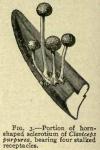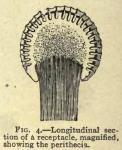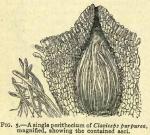5. Ergota.—Ergot. (Ergot of Rye).
 The carefully dried sclerotium of fungus Clav'iceps purpu'rea Tulasne (Pam. Hypocreaceae), replacing the grains of rye, Secale cereale Linné (Gramineae), with not more than 5 per cent. of harmless seeds, fruits and other foreign matter.
The carefully dried sclerotium of fungus Clav'iceps purpu'rea Tulasne (Pam. Hypocreaceae), replacing the grains of rye, Secale cereale Linné (Gramineae), with not more than 5 per cent. of harmless seeds, fruits and other foreign matter.
DEVELOPMENT.—Selerotium described: The early stage of the fungus consists of a profuse growth of mycelium in the tissues and upon the surface of the young ovary. In the "sphacelia" stage, as it is called, a multitude of conidia (non-sexual spores) are produced on the ends of the hyphae; after the conidial stage the mycelium at the base of the ovary becomes greatly increased and assumes a hard and compact form. It grows with considerable rapidity, and carries upon its summit the old sphacelia and the remains of the now destroyed ovary. The compact, horn-shaped, dark-colored body which results (and is official) is called the sclerotium, which occupies the position of the displaced ovary. This sclerotium remains dormant in winter, and in the spring produces spores, as follows: stalked receptacles (Fig. 3) grow up from the tissue of the ergot, in which are developed a number of perithecia (Fig. 4). These perithecia are somewhat flask-shaped cavities (Fig. 5) filled with asci (Fig. 5), the latter containing long, slender spores termed ascospores (Fig. 6), which again, by germinating on the rye and other grasses, give rise to a new growth, and to the development of Claviceps. Ergot, in short consists in its earliest stage of a mass of mycelium (threads or filaments of fungi) in and upon the growing ovary. Conidia are produced (non-sexual spores) in great abundance which quickly germinate.
 Following the conidial stage the mycelium at the base of the ovary assumes a hard and compact form, increases in size, becoming a horn-shaped and darkcolored body, the so-called ergot. Such a compact mass of hyphae (the vegetative threads or filaments of the fungi) is called a sclerotium.
Following the conidial stage the mycelium at the base of the ovary assumes a hard and compact form, increases in size, becoming a horn-shaped and darkcolored body, the so-called ergot. Such a compact mass of hyphae (the vegetative threads or filaments of the fungi) is called a sclerotium.
The official fungus grows on rye, but the ergot also grows on other grasses and some of these ergots from other grasses have been found to be stronger than that of rye. The different grades are Russian, German, Austrian, Spanish and Swedish.
PREPARATION AND PRESERVATION.—Ergot should be dried without artificial heat kept in tin or glass containers free from light. A few drops of chloroform or carbon tetrachloride should be added from time to time to prevent development of insects. The powdered drug should not be kept longer than one year. Suggestion for preservation—keep over slaked lime. Dip into ethereal solution of tolu and keep in stoppered bottles. Also by removing the oil from the drug.
DESCRIPTION OF DRUG.—The official ergot of rye is from 10 to 30 mm. (⅖ to 1 ⅕ in.) long and from 2 to 6 mm. (1/12 to ¼ in.) in diameter. On other grasses it is usually of less size. Triangular, slightly curved, tapering toward, but obtuse at, the ends; externally purplish-black, internally whitish with pinkish lines; fracture short (not very brittle). If a portion be macerated in water containing hydrate of potassium or sodium, then carefully crushed under the blade of a spatula, the fragments of mycelium threads are plainly discernible under the microscope. Odor (especially in powder or when treated with an alkali) heavy and unpleasant; taste oily and disagreeable.
When more than one year old, it is unfit for use. Old ergot, which breaks with a sharp snap, is almost devoid of pinkish tinge upon the fracture, is hard and brittle between the teeth, and is comparatively odorless and tasteless, should be rejected.
CONSTITUENTS.—The active constituents of ergot are still somewhat in doubt due probably to the amorphous condition in which they exist. Barger and Carr have extracted a substance called ergotoxine (noncrystalline) to which the dangerously poisonous character of ergot is due including the power to produce gangrene. Barger and Dale have shown it to contain amines derived from amino acids. Two of especial physiological activity are:
- p. Hydroxyphenylethylamine or (Tryamine) has action of same type as active constituents of suprarenal glands and substance chiefly concerned in standardization of ergot by rise in blood pressure.
- b. Iminoazolethylamine (Ergamine) has an action of peculiar intensity on plain muscle especially on uterine muscle.
Ergotine an alkaloid thought by some to be identical with ergotonine. Ecboline same as cornutine. Others say ergotine and ecboline are identical. Different samples of ergot may contain very different amounts of the three main constituents. The yield of ash should not exceed 5 per cent.
Assay of Ergot.—The physiological test for ergot, originated by E. M. Houghton, consists in feeding the preparation or drug to roosters, and noting the blackened and gangrenous appearance produced in the comb and wattles. The rapidity with which this change takes place and the depth of color produced denote the strength of the drug. An assay of the drug can be made by estimating the proportion of cornutine present, which, according to Beckurts, is as follows: 25 Gm. of the drug are freed from oil by percolation with petroleum spirits, then dried and well shaken with 100 Gm. of ether and 1 Gm. of magnesia, the latter having been suspended in 20 mils of water. After repeated agitation the mixture is allowed to stand for three or four hours. Then 60 Gm. of the clear ethereal solution (to 15 Gm. of ergot) are shaken four successive times with 25, 10, 10, and 10 mils of dilute HCl (0.5 per cent.), the united solutions rendered alkaline by NH4OH, and the alkaloid shaken out with three successive portions of ether. On evaporation, drying, and weighing the somewhat crystalline yellowish-white cornutine the assay is completed. The results of such assay are unsatisfactory, but have proved of value as a check in qualitative estimations.
Preparation of Ergotin (Wiggers).—Treat ergot with ether to deprive it of fixed oil, then extract with hot alcohol, evaporate, and purify. It resembles cinchonic red, is soluble in alcohol, but insoluble in ether and water. Bonjeau's ergotin corresponds to a purified extract of ergot (aqueous extract, precipitated by alcohol, filtered, and evaporated); is soluble in alcohol and water.
ACTION AND USES.—Produces vascular contraction, especially of the arteries, all over the body. This property is said to be due to its action on the vasomotor centers in the cord. Because it contracts the arterioles it is hemostatic. The flow of urine is also diminished. It is ecbolic and parturient, powerfully exciting the pregnant uterus and expelling its contents. Recently it has been discovered to be of value in the treatment of insomnia, the sleep produced being more natural than that from other drugs.
Poisonous symptoms: dimness of vision, local anesthesia, and numbness are sometimes produced, even by medicinal doses. Antidotes: evacuants (stomach-pump, emetics, etc.), stimulants, nitrite of amyl, inhalations, friction, etc. Dose: 20 to 30 gr. (1.3 to 2 Gm.) in freshly prepared powder, wine, or fluidextract; ergotin solution, 1 to 3 gr. 0.65 to 0.2 Gm.)
- OFFICIAL PREPARATIONS.
- Extractum Ergotae, Dose: 3 to 12 gr. (0.2 to 0.8 Gm.)
- Fluidextractum Ergotae, Dose: ½ to 2 fl. dr. (2 to 8 mils)




